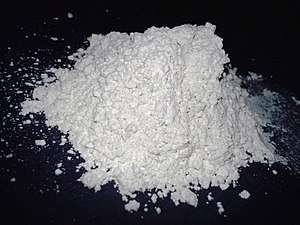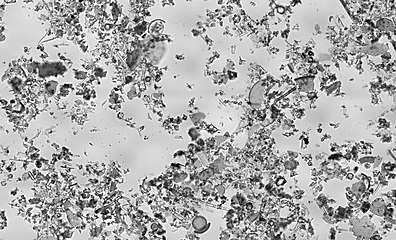Diatomaceous earth
Diatomaceous earth ( /ˌdaɪ.ətəˌmeɪʃəs ˈɜːrθ/, DE), diatomite or kieselgur/kieselguhr is a naturally occurring, soft, siliceous sedimentary rock that is easily crumbled into a fine white to off-white powder. It has a particle size ranging from less than 3 μm to more than 1 mm, but typically 10 to 200 μm. Depending on the granularity, this powder can have an abrasive feel, similar to pumice powder, and has a low density as a result of its high porosity. The typical chemical composition of oven-dried diatomaceous earth is 80–90% silica, with 2–4% alumina (attributed mostly to clay minerals) and 0.5–2% iron oxide.[1]

Diatomaceous earth consists of fossilized remains of diatoms, a type of hard-shelled protist. It is used as a filtration aid, mild abrasive in products including metal polishes and toothpaste, mechanical insecticide, absorbent for liquids, matting agent for coatings, reinforcing filler in plastics and rubber, anti-block in plastic films, porous support for chemical catalysts, cat litter, activator in blood clotting studies, a stabilizing component of dynamite, a thermal insulator, and a soil for potted plants and trees like bonsai.[2][3]

Specific varieties
- Tripolite is the variety found in Tripoli, Libya.
- Bann clay is the variety found in the Lower Bann valley in Northern Ireland.
- Moler (Mo-clay) is the variety found in northwestern Denmark, especially on the islands of Fur and Mors.
- Freshwater-derived food grade diatomaceous earth is the type used in United States agriculture for grain storage, as feed supplement, and as an insecticide. It is produced uncalcinated, has a very fine particle size, and is very low in crystal silica (<2%).
- Salt-water-derived pool / beer / wine filter grade is not suitable for human consumption or effective as an insecticide. Usually calcinated before being sold to remove impurities and undesirable volatile contents, it is composed of larger particles than the freshwater version and has a high crystalline silica content (>60%).
Microbial degradation
Certain species of bacteria in oceans and lakes can accelerate the rate of dissolution of silica in dead and living diatoms; by using hydrolytic enzymes to break down the organic algal material.[31][32]
Climatologic importance
The Earth's climate is affected by dust in the atmosphere, so locating major sources of atmospheric dust is important for climatology. Recent research indicates that surface deposits of diatomaceous earth play an important role. Research shows that significant dust comes from the Bodélé depression in Chad, where storms push diatomite gravel over dunes, generating dust by abrasion.[33]
Safety considerations
Inhalation of crystalline silica is harmful to the lungs, causing silicosis. Amorphous silica is considered to have low toxicity, but prolonged inhalation causes changes to the lungs.[34] Diatomaceous earth is mostly amorphous silica, but contains some crystalline silica, especially in the saltwater forms.[35] In a study of workers, those exposed to natural D.E. for over 5 years had no significant lung changes, while 40% of those exposed to the calcined form had developed pneumoconiosis.[36]Today's common D.E. formulations are safer to use as they are predominantly made up of amorphous silica and contain little or no crystalline silica.[37]
The crystalline silica content of D.E. is regulated in the United States by the Occupational Safety and Health Administration (OSHA), and there are guidelines from the National Institute for Occupational Safety and Health setting maximum amounts allowable in the product (1%) and in the air near the breathing zone of workers, with a recommended exposure limit at 6 mg/m3 over an 8-hour workday.[37] OSHA has set a permissible exposure limit for diatomaceous earth as 20 mppcf (80 mg/m3/%SiO2). At levels of 3000 mg/m3, diatomaceous earth is immediately dangerous to life and health.[38]
In the 1930s, long-term occupational exposure among workers in the cristobalite D.E. industry who were exposed to high levels of airborne crystalline silica over decades were found to have an increased risk of silicosis.[39]
Today, workers are required to use respiratory-protection measures when concentrations of silica exceed allowable levels.
Diatomite produced for pool filters is treated with high heat (calcination) and a fluxing agent (soda ash), causing the formerly harmless amorphous silicon dioxide to assume its crystalline form.[37]
See also
- Biomineralization – Process by which living organisms produce minerals
- Diatom – A class of microalgae, found in the oceans, waterways and soils of the world
- Frustule
- Fuller's earth – Any clay material that can decolorise oil or other liquids
- Perlite – Amorphous volcanic glass
- Rock flour
- Silica aerogel
- Siliceous ooze
- Zeolite – Microporous, aluminosilicate minerals commonly used as commercial adsorbents and catalysts
References
- <reand so and so f name="USGS">Antonides, Lloyd E. (1997). Diatomite (PDF). USGS. Retrieved December 12, 2010.
- Reka, Arianit A.; Pavlovski, Blagoj; Ademi, Egzon; Jashari, Ahmed; Boev, Blazo; Boev, Ivan; Makreski, Petre (December 31, 2019). "Effect Of Thermal Treatment Of Trepel At Temperature Range 800-1200˚C". Open Chemistry. 17 (1): 1235–1243. doi:10.1515/chem-2019-0132.
- Reka, Arianit; Anovski, Todor; Bogoevski, Slobodan; Pavlovski, Blagoj; Boškovski, Boško (December 29, 2014). "Physical-chemical and mineralogical-petrographic examinations of diatomite from deposit near village of Rožden, Republic of Macedonia". Geologica Macedonica. 28 (2): 121–126.
- "Diatoms". UCL London's Global University. Retrieved September 14, 2011.
- Antonides, Lloyd E. (1997). Diatomite (PDF). USGS. Retrieved December 12, 2010.
- "History of Diatoms – What Is Diatomaceous Earth". Diatomaceous. Diatomaceous Organization. Retrieved October 12, 2018.
- "Diatomaceous Earth (one of my new favorite products)". Homesteading Stewards. June 5, 2012. Retrieved October 12, 2018.
- Klebs, Florian (December 17, 2001). "Deutschland - Wiege des Nobelpreis: Tourismus-Industrie und Forschung auf den Spuren Alfred Nobels" (in German). Alexander von Humboldt Foundation. Archived from the original on November 17, 2002. Retrieved October 12, 2018.
- "Was ist es um die Kieselgur?". Archived from the original on September 28, 2007. Retrieved March 10, 2010. Über den früheren Abbau von Kieselgur im Vogelsberg/Hessen
- Geschichte des Kieselgurabbaus in Klieken Archived April 20, 2008, at the Wayback Machine
- "SKYE DIATOMITE: A LOST INDUSTRY". www.stornowaygazette.co.uk.
- Cummins, Arthur B., Diatomite, in Industrial Minerals and Rocks, 3rd ed. 1960, American Institute of Mining, Metallurgical, and Petroleum Engineers, pp. 303–319
- Davis, Jr., John H. (1946). The Peat Deposits of Florida Their Occurrence, Development and Uses, Geological Bulletin No. 30. Florida Geological Survey.
- Rustan, Agne (February 1, 1998). Rock Blasting Terms and Symbols: A Dictionary of Symbols and Terms in Rock Blasting and Related Areas like Drilling, Mining and Rock Mechanics. Taylor & Francis. p. 83. ISBN 978-1-4665-7178-5.
Bulson, P.S. (July 24, 1997). Explosive Loading of Engineering Structures. CRC Press. p. 3. ISBN 978-1-135-82980-3. - "BERKEFELD & AQUANTIS Water Treatment - Veolia Water Technologies". technomaps.veoliawatertechnologies.com.
- Amos Ives Root; Ernest Rob Root (March 1, 2005). The ABC And Xyz of Bee Culture. Kessinger Publishing. p. 387. ISBN 978-1-4179-2427-1.
- Fields, Paul; Allen, Sylvia; Korunic, Zlatko; McLaughlin, Alan; Stathers, Tanya (July 2002). "Standardized testing for diatomaceous earth" (PDF). Proceedings of the Eighth International Working Conference of Stored-Product Protection. York, U.K.: Entomological Society of Manitoba.
- Lartigue, E. del C.; Rossanigo, C. E. (2004). "Insecticide and anthelmintic assessment of diatomaceous earth in cattle". Veterinaria Argentina. 21 (209): 660–674.
- Fernandez, M. I.; Woodward, B. W.; Stromberg, B. E. (1998). "Effect of diatomaceous earth as an anthelmintic treatment on internal parasites and feedlot performance of beef steers". Animal Science. 66 (3): 635–641. doi:10.1017/S1357729800009206.
- Faulde, M. K.; Tisch, M.; Scharninghausen, J. J. (August 2006). "Efficacy of modified diatomaceous earth on different cockroach species (Orthoptera, Blattellidae) and silverfish (Thysanura, Lepismatidae)". Journal of Pest Science. 79 (3): 155–161. doi:10.1007/s10340-006-0127-8.
- "Diatomaceous Earth: Protect Food Storage". diatomaceousearth.com. Retrieved March 8, 2020.
- Capinera, John L. (2008). "Diatomaceous earth". In Capinera, John L. (ed.). Encyclopedia of Entomology (Second ed.). Springer. p. 1216. ISBN 978-1-4020-6242-1.
- "Pesticide Labeling Questions & Answers - Advertising Claims". EPA. Archived from the original on May 30, 2013. Retrieved July 7, 2013.
- Flynn, Thomas M. "Cryogenic Equipment and Cryogenic Systems Analysis." Cryogenic Engineering. Boca Raton etc.: CRC, 2005. Print.
- Nishimura, Shigeo (2001). Handbook of Heterogeneous Catalytic Hydrogenation for Organic Synthesis (1st ed.). Newyork: Wiley-Interscience. pp. 2–5. ISBN 9780471396987.
- "Prevention and Management of Insects and Mites in Farm-Stored Grain". Province of Manitoba. Archived from the original on October 18, 2013. Retrieved July 7, 2013.
- "21 CFR 573.340 - Diatomaceous earth" (PDF). Code of Federal Regulations (annual edition)—Title 21 - Food and Drugs—Part 573 - Food additives permitted in feed and drinking water of animals—Section 573.340 - Diatomaceous earth. Food and Drug Administration/U.S. Government Publishing Office. April 1, 2001. Retrieved February 9, 2016.
- "Diatomaceous Earth (DE)".
- Ferraz, E.; Coroado, J.; Silva, J.; Gomes, C.; Rocha, F. (2011). "Manufacture of ceramic bricks using recycled brewing spent kieselguhr". Materials and Manufacturing Processes. 26 (10): 1319–1329. doi:10.1080/10426914.2011.551908.
- Reka, Arianit A.; Pavlovski, Blagoj; Makreski, Petre (October 2017). "New optimized method for low-temperature hydrothermal production of porous ceramics using diatomaceous earth". Ceramics International. 43 (15): 12572–12578.
- Bidle, Kay D.; Azam, Farooq (February 1999). "Accelerated dissolution of diatom silica by marine bacterial assemblages". Nature. 397 (6719): 508–512. Bibcode:1999Natur.397..508B. doi:10.1038/17351.
- Zakharova, Yulia R.; Galachyants, Yuri P.; Kurilkina, Maria I.; Likhoshvay, Alexander V.; Petrova, Darya P.; Shishlyannikov, Sergey M.; Ravin, Nikolai V.; Mardanov, Andrey V.; Beletsky, Alexey V.; Likhoshway, Yelena V.; Mormile, Melanie R. (April 1, 2013). "The Structure of Microbial Community and Degradation of Diatoms in the Deep Near-Bottom Layer of Lake Baikal". PLOS ONE. 8 (4): e59977. Bibcode:2013PLoSO...859977Z. doi:10.1371/journal.pone.0059977. PMC 3613400. PMID 23560063.
- Washington, R.; Todd, M. C.; Lizcano, G.; Tegen, I.; Flamant, C.; et al. (2006). "Links between topography, wind, deflation, lakes and dust: The case of the Bodélé Depression, Chad" (PDF). Geophysical Research Letters. 33 (9): L09401. Bibcode:2006GeoRL..33.9401W. doi:10.1029/2006GL025827. ISSN 0094-8276.
- "NIOSH 1988 OSHA PEL Project Documentation: List by Chemical Name: SILICA, AMORPHO". CDC. September 19, 2018.
- "Diatomaceous Earth: Its Use and Precautions" (PDF). Archived from the original (PDF) on July 17, 2013. Retrieved November 9, 2013.
- "Occupational Health Guideline for Amorphous Silica" (PDF). CDC. September 1978. Archived (PDF) from the original on March 12, 2020. Retrieved March 24, 2020.
- "Wayback Machine" (PDF). July 10, 2003. Archived from the original (PDF) on July 10, 2003.
- "NIOSH Pocket Guide to Chemical Hazards - Silica, amorphous". CDC. Retrieved November 21, 2015.
- Hughes, Janet M.; Weill, Hans; Checkoway, Harvey; Jones, Robert N.; Henry, Melanie M.; Heyer, Nicholas J.; Seixas, Noah S.; Demers, Paul A. (1998). "Radiographic Evidence of Silicosis Risk in the Diatomaceous Earth Industry". American Journal of Respiratory and Critical Care Medicine. 158 (3): 807–814. doi:10.1164/ajrccm.158.3.9709103. ISSN 1073-449X. PMID 9731009.
External links
- International Chemical Safety Card 0248
- CDC – NIOSH Pocket Guide to Chemical Hazards
- Diatomite: Statistics and Information – USGS
- Tripolite: Tripolite mineral data Citat: "...A diatomaceous earth consisting of opaline silica..."
- DIATOMACEOUS EARTH: A Non Toxic Pesticide